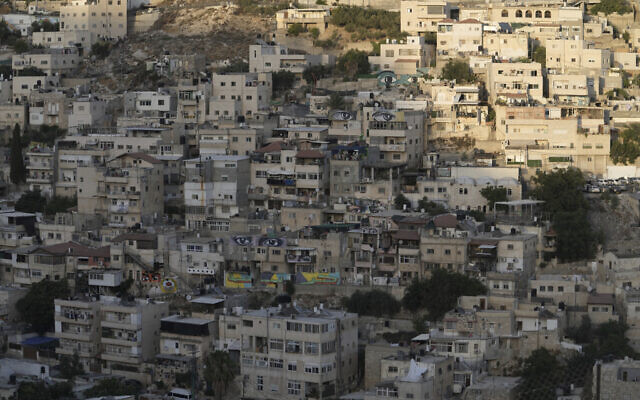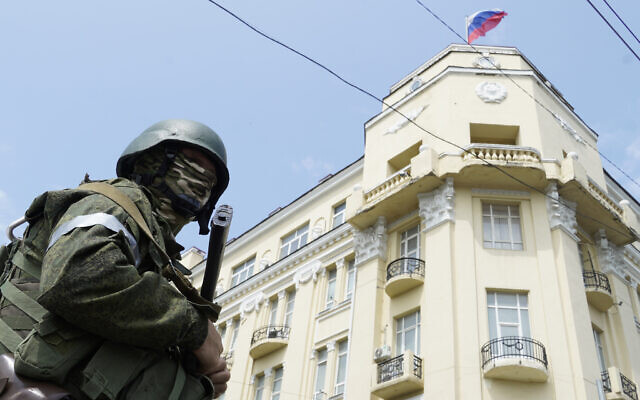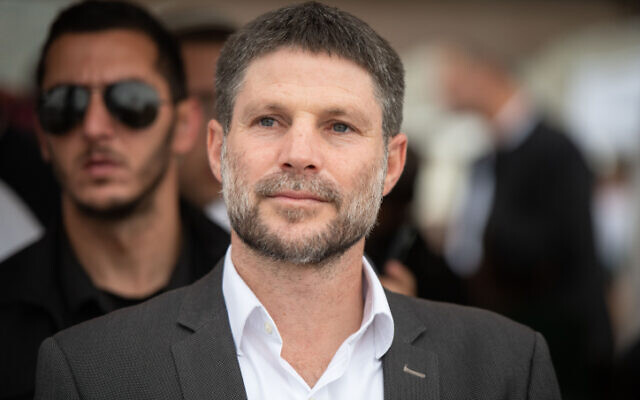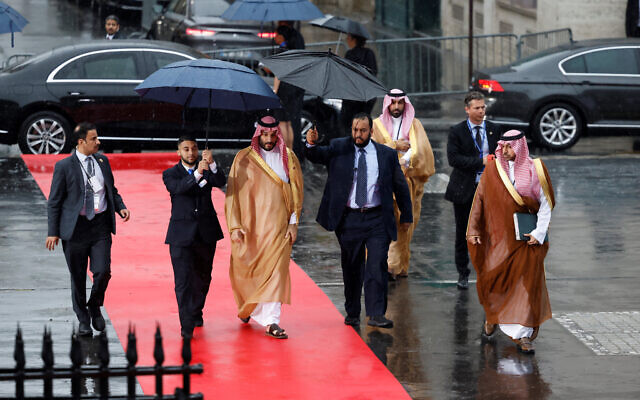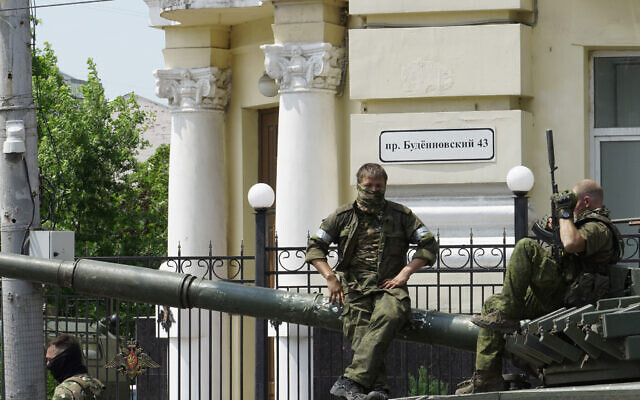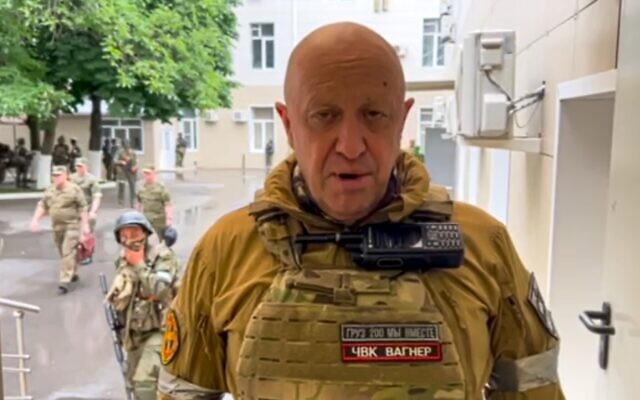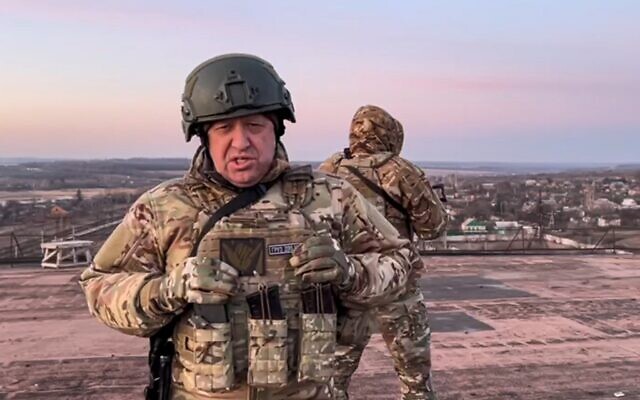What Matters Now to Prof. Mona Khoury: The cycle of violence in Arab communities
With over 100 Arab Israelis dead through violence in the first half of 2023, this academic says it’s time to stop the blame game and start coming up with a comprehensive plan
Welcome to What Matters Now, a weekly podcast exploration into one key issue shaping Israel and the Jewish world — right now.
This past weekend, Israel marked a tragic milestone: In the first half of 2023, over 100 Arab citizens have died by violence.
Just like its manifestation in every community throughout the world, this scourge has many faces — organized crime, domestic violence, random acts of anger, and more. But according to polling by the Abraham Initiative, for several years running, members of Arab communities have said that the issues that most concern them are crime and violence, well above civil status, racist legislation and the stalemate in the peace process.
However, many Arab citizens of Israel feel that the Jewish state just isn’t putting the resources into fighting the wave of violence in a long-term, comprehensive way.
“People are talking about it as the violence in the Arab society. First of all, it’s the violence in the Israeli society,” said Prof. Mona Khoury, Vice President for Strategy and Diversity at the Hebrew University of Jerusalem.
Khoury, a full professor at the Hebrew University School of Social Work, sat with The Times of Israel in her Mount Scopus office this week. Much of her research focuses on children and adolescents’ deviant and delinquent behaviors.
But instead of merely studying the phenomena, she has concrete suggestions for breaking the cycle of violence.
This week, when all eyes are finally on the uptick of violence in Arab communities, we ask Prof. Khoury, what matters now.
The following transcript has been lightly edited.
The Times of Israel: Mona, thank you so much for allowing me to join you in your Hebrew University office here at the Mount Scopus campus.
Prof. Mona Khoury: Thank you for coming.
Such a pleasure to be here. Our topic at hand is less pleasurable, of course. This past weekend we saw a record high of over a hundred members of the Arab Israeli community dead, due to violence in the community. And so I’m here to ask you, what matters now?
I think it is the way people feel now, the lack of safety that many people, parents, children, and everyone feels in Arab society these days, even people that are not involved at all in violence, delinquency, or in any kind of deviant behavior. Many people now feel unsafe in their homes and neighborhoods.
And in fact, obviously, most people are not involved in violence or delinquent behavior.
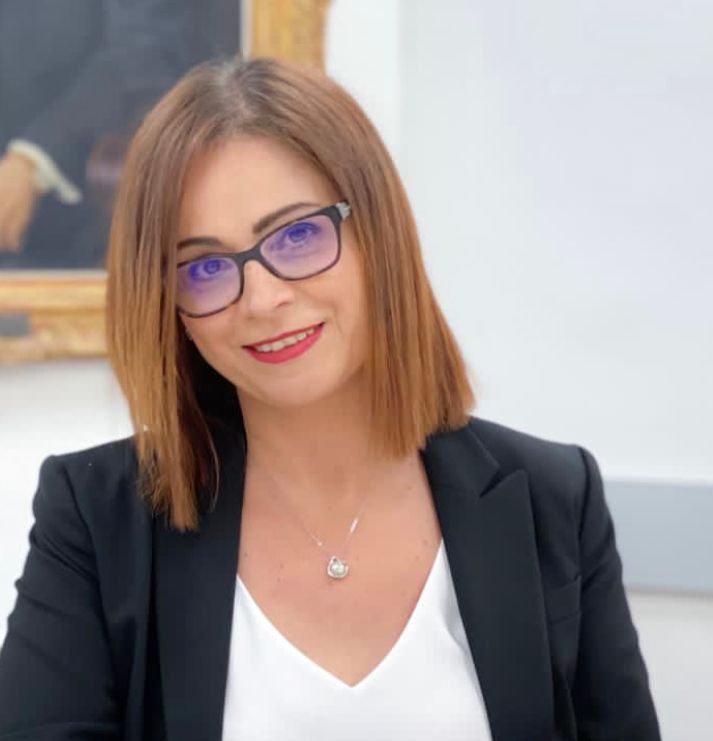
Of course, this is actually the main thing that people should know. Even though we have 100 people who were killed, many of them are not involved, even the victims are not involved in violence — some of them were just in the wrong place, in the wrong time, and unfortunately, they were killed.
But another thing that people should know is that despite this high percentage of people who are involved in violence in Arab society, it is still a very small number compared to the fact that we are 2 million here in Israel. The killing of one person is high, still, if we compare it to the larger the size of the population, it is a very large population and most of it is not violent. And unfortunately, these people make it look like that the Arab population is violent, or all the Arab population is violent.
And in fact, just saying “the Arab population is not accurate.” There are many Arab populations. So for our listeners who have perhaps never been to Israel, can you break down just broad strokes: What are these different populations that make up the Arab population?
So if we are talking about the Arab population or about the citizens of Israel who are Arabs, we are talking about mainly three groups. The Muslim Arab population, that is the majority of the Arab population in Israel, and it is almost 84% of the Arab population. We have the Christian Arab population, which is 8% of the Arab population. And we have the third group, the Druze population, which is also almost 8% of the Arab population in Israel. And also within these groups we have also differences between Arabs who live in the cities, Arabs who live in villages, Arabs who live in the northern part of Israel, compared to those who live in the central part of Israel, or the Bedouin population that mostly lives in the southern part of Israel.
Most of your research, as far as I understand it, has dealt with youth and one of the numbers that I saw in one of your papers was something like 28% of those youth who participated in your study had perpetrated some kind of violence. Is that accurate?
First of all, it’s accurate. It’s an unfortunate number that we know that Arab youth are involved, disproportionately to their percentage in the Israeli population, in violence and delinquency. Especially if we’re looking at the official data, it looks like 54% of the crimes are committed by Arab youth while their percentage is almost 26% in the Israeli population. So it’s much higher. And when we are looking at self-reported studies that we have, we also see that Arab youth report more than Jewish students on violence.
Still, the differences between them or the gap is larger when we are talking about severe kinds of violence. When you have physical violence that you need to go for medical treatment or something like that. There is no moderate kind of violence, violence is violence, but in order to differentiate between the types, when we are talking about pushing, slapping, and then in the school, we see that the Arab youth and the Jewish youth are involved in almost the same percentage of this kind of violence.
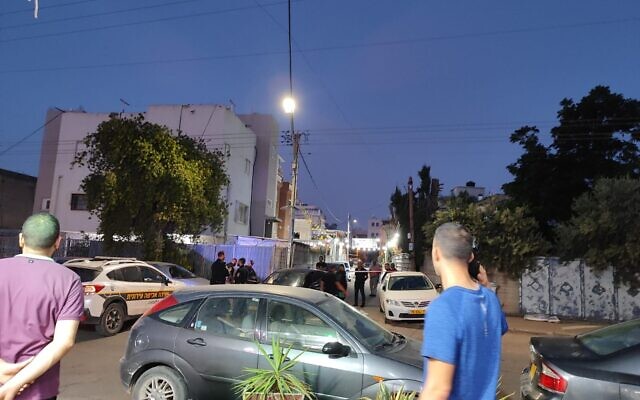
So just to reiterate what you said, when it comes to school ground fights, things of that nature, Arab youth and Jewish youth are about the same. But then when you take it up a notch when it comes to needing medical attention and things of that sort, then Arab youth — self-reported, we must remind people — jump the gap.
Exactly. And this is actually, emphasizing the self-reported aspect, because it is the same as when we are talking about crime and official reports. So, we know that Arab youth also self-report specifically on severe kinds of violence. They report more than Jewish kids. For example, in carrying weapons to school we know that Arab children report higher than Jewish children on carrying weapons to school. So this is one kind of severe act of violence and delinquency.
Is that because perhaps there aren’t guards at the gates of the school as there are in Jewish schools? Or what would cause that to happen?
I don’t think the reason is guards, because there are some guards in Arab schools. I’m not sure in all of them, I’m not sure they look, so it’s not the existence of the guard. But most of the studies show that checking is not actually the main reason for decreasing the numbers.
One of the things that we know, and it in some way reminds us of what’s going on in the United States, is the access to the weapon. We can see it now with all the killings in Arab society. We can see the number of weapons that exist in homes in Arab society. So I believe this is one of the reasons that access to weapons is easier for Arab children in some cases.
We also should remember we are talking about a very small number of children who carried weapons to school, but you know, one gun can kill a lot of people.
For sure, as we saw last week with the unfortunate shooting that killed five at a car wash. Now, I want to ask you about one of the statements that I saw in one of your papers, which is basically talking about a Catch-22 cycle. Meaning Arab youth who witnessed violence in their communities are more likely to perpetuate violence. Talk to us a little bit about this.
Yeah, actually, this is exactly what happens. And the results show, first, that Arab youth are highly exposed to violence in their communities. If we are talking about personal experience, 50% of the participants indicated that they were a victim of any kind of violence during the last month in their neighborhood. And when we ask them if they witnessed someone who was a victim of violence, the number goes to 80%.
So Arab youth, even if they are not victims, they almost all the time see violence in their surrounding area. And we found that this is one of the predictors of being a violent kid.
So Arab youth who live in this environment are highly exposed to violence and then they use their violence in some cases toward their parents, toward their siblings, and toward their friends in the school. So it is like a circle, that we have to do something in order to change the situation. And of course, one of the main things is stopping the violence in Arab society.
But that’s such a huge task. Let’s break it down, like your papers do, into the different frontiers, starting with the home.
Yes. So first of all, it’s a big issue and a serious problem and it will take time to solve it, the violence in Arab society. So there are many things, I as a social worker, can say that there are many interventions and many things that we know from research that are very helpful. For example, in this situation I explained about community violence, which predicts violence. But one of the things that we found in our studies is that when a kid has a good relationship with their parents and when they have parents who are involved in their life and have good communication with them, the effect of community violence or exposure to community violence is lower than when you have a bad relationship with your parents.
So this is something that we can do, even if we are not solving the situation in Arab communities now, to which I say we should do something, but at least we can work now with parents. And professionals who worked in schools, in social services and in other places should know and be aware of the huge effect that parents have on their youth, and on their teenagers. In many cases we hear that parents don’t have this much of an influence on their teenage children, but it’s not true. Research shows that it has. And we should also work on family therapy and not only focusing on the violent kid, we have to involve the parents as an important part of our intervention.
So I will say it again more simply: If we have two kids who are exposed to the same level of violence, and one of them has a good relationship with his or her parents and the other one doesn’t, we can see that the one who has a good relationship will not be as affected as his friend from being exposed to violence.
So it sounds like what you’re saying is that, to prevent even getting to a “problem child” — I hate that term — but to prevent a position in which a child is acting out, the parents need to be instructed ahead of time how to be better parents, and to raise better children?
Of course. And one of the main things is working with parents when their children are very young. We know also from my studies that children start their violence very, very early and we know that violence starts also in kindergartens.
Kindergarten teachers report on the children in their classes, that they are violent. Mothers in my study reported that their children, three to five years old, were also violent. And one of the main things that we are talking about is working with the parents. In many situations, we hear that staff, in this case the kindergarten teacher or the staff in schools say that the parents also use violence against their children. So, they say, we have nothing to do.
And this is the main problem, and the main challenge is that when you say we don’t have to do anything, you are giving up on this child and we can’t blame him and we can’t let it go with this situation. What we have to do is work with the parents, and show them that this actually will result in having a child who is violent, and to have intervention and prevention efforts, in that respect.
So I’m the mother of four teenagers, and you say that I have some influence on them, but it doesn’t always feel like that, and it really feels like their friend group has a lot more influence on them at this point. So how do we make better nonviolent friend groups for this age as well?
So you are touching on a very important part, which is friends. We know that a peer group during the teenage years has a tremendous effect on children. But the friends of your kids, they don’t come up suddenly. They are in many cases, usually, as you said, you have a 14-year-old child, you know that many of his friends are friends for many years and you have to work on that also and to be aware of with whom your child is going, with whom they are hanging out, what happens there. And in some cases, yes, to involve other parents, if you know something, to take your kids to professional intervention, to talk with the teachers, because in many cases these are classmates or schoolmates, so they know each other from some place. If you look at children, usually they hang out with people that they know from their normal environment, neighborhood classes, schools, so we can do something also with the peer group.
But again, the studies show that also the effect of the peer group is lower. Even if it’s a delinquent peer group, it is lower when you have a good relationship with your parents. So we believe in some way because children spend a lot of time with their friends that we don’t have this much of an effect, but we do. Because imagine your child is growing up with you, with the values you are teaching them, with everything you are telling them and with the way you behave for many years, so it doesn’t disappear. It’s something like speaking, talking, walking, everything.
And violence is something that develops, and being pro-social is something also. We develop this, based on what we see in our environment. So if you raise your child on these values, that they should not be violent and you give them the tools and the skills on how not to be violent, even in conflict situations they will use it later. They don’t need you to be with them everywhere. Because I’m not saying you have to go hang out with your kid, which is something that, unfortunately, parents think that they should do it by following and tracking their phones and these things. And we know that it’s not helpful. So it’s better to be aware of all the things that you can do with your children when they are young, rather than tracking their phones and the apps that they use.
In your research, are you finding differences between males and females?
Yes, we know that males are much more violent than females, in almost all indicators of violence. There are inconsistent results regarding what we call “indirect violence.” In the beginning, the results show that females are more violent in that type of violence. And when I’m talking about indirect violence, we are talking about gossiping. Spreading rumors, and…
All the “mean girl” tactics
Yes, they would call it this. And many people like to say: “Yeah, it’s something that girls like to do.” But the study shows even when the females were higher, the males still do it. And this we should remember. It wasn’t like the females do it like 60% and males 1%. No, it was like maybe 65% compared to 55%. So, it means all of them are doing that. In some way, females do it more. But one of the explanations is that females do it as part of being violent, in a way that is culturally accepted, while they are not or they won’t to use physical violence, as males will. So this is the way they can express in some way their anger, solve conflict, by using this kind of violence.
We’ve identified a lot of the issues at stake for the youth in particular, now I’d like to talk about some ways that we can solve it.
So we implemented a comprehensive program, in which a lot of collaborators were involved and it included social services, probation officers, social workers who work at the Division of Children at Risk, the police, the Justice Ministry, and other factors who are involved in this project. And all of them worked in order to change the situation, and of course the municipality of Jerusalem and the education system.
So, each one of them did something in his field. So the police changed, for example, the way the police act in these neighborhoods. The education system gave extracurricular activities after the school day ended. The social probation officers were more involved. The Division for Youth at Risk, which was the most important, I believe, element in that because they organized all the activities, they gave intervention for the children and also worked with the parents.
So, this comprehensive activity helped in decreasing the involvement of the participants. Actually, this was an evaluation study and we saw that their participation affected their behavior and they were less violent at the end of this intervention.
How long was this intervention?
It was at least a year. These kids, some of them are still in this intervention and one of the things is that these kids have a criminal record on stone-throwing. But the deal they got is that if they go into this intervention, they will not go into court, so their file will be frozen for this time, and if they go to the intervention, it will be closed after a while.
In the first year, many of the parents and the kids didn’t want to participate, and they were very suspicious. And lately, I met the head of the Division for Youth at Risk, and she said, now parents are asking me to take their kids to this intervention in order to help them. Because we also saw in this study, and in a larger study among a large sample of youth in East Jerusalem, this study focused on youth in East Jerusalem, that there is a strong relationship between being involved in stone-throwing and the “regular violence,” that we call it.
So, these kids were involved also, in additional types of violence and delinquency and when they participated in intervention or any activity, it helped also in decreasing their overall participation in crime, and not only in this specific one.
They had a huge incentive to participate. But if you put that even to the side, it sounds like the parents were seeing a huge change in their children’s peers, and so they’re asking to be part of this program. So is this the kind of program that can be broadened more nationally?
Actually, it’s not national, for now. They are broadening, because it started in one neighborhood, and now they are implementing it in three additional neighborhoods in Jerusalem. So they are trying to do that, and I believe in the future it will be implemented in other places in Israel. But it should have this adaptation because we are talking here about a specific kind of criminal activity and specific circumstances that we have in East Jerusalem.
But the main idea of this intervention is that it involves all the resources that the kids are usually in touch with and that they have the ability to support and help. The social services don’t have the ability to give extracurricular activities, but when the education system is involved they could do the change in the school and when the police is involved, they can do the change in the neighborhood. So this is the way that you can change everything, but while you are focusing only on the violent child it’s very difficult to make the change because at the end of the day they go home, and they go to their neighborhoods and as we mentioned, it’s full of violence.
It sounds like this would require a huge amount of oversight and budget. And do you see either of those being given to Arab communities?
I hope so. The situation is so bad that if they don’t do that, it will get worse, it will not be solved. There is no way that this situation will be better without investing all these resources. So something should be done.
Now people are talking about it as “violence in the Arab society.” First of all, it’s violence in the Israeli society. Once we consider it or define it this way, the change will start. Because as long as you are looking at it as a problem of only the Arab society in Israel, it will not be an interest of anyone in the government. But when you look at it as a problem in Israeli society and unfortunately, I don’t want to say this, but what happens in the Arab villages and cities at some time, will go also for the Jewish neighborhoods and cities. And what I’m trying to say that it’s better to solve this problem now, otherwise we will get into an additional kind of conflict, and you will never know how it will develop after that.
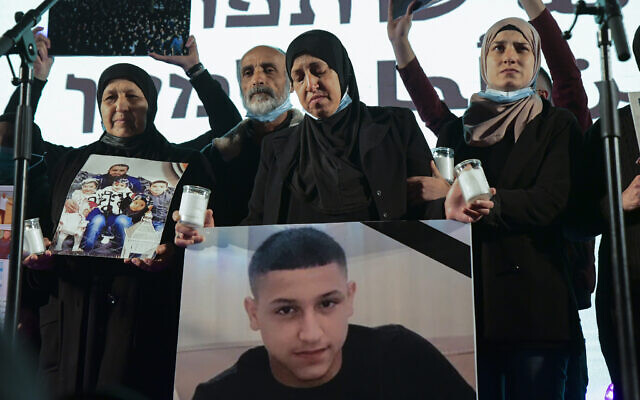
It sounds like what you’re hinting at is a more extremist population, a more militant population. And already, as I understand it, many Arab citizens of Israel don’t have much confidence in the police or in Israeli bureaucracy in general, is that correct?
Yeah, actually studies show that it’s not only something that we feel or we know — studies that explore this topic showed that the Arab population feels that they are treated in a different way than the Jewish population by the police and other offices in Israel.
And when you have no trust in the police, unfortunately, you will turn to other resources to solve your problems. And this is in some way what happens now in Arab society: People are not turning to the police because they don’t have any confidence in them and they don’t believe that they are here to help them.
In many ways, the Arab population perceives the police as something that is against them. And, if you look at the way the police treated the Arab population for many years, they treated us as enemies. So it’s from both parts — there is no trust, and this is actually what happens. So you can explain the Arab situation now, people may say, “Oh, they don’t want to go and to cooperate with the police,” it’s because they don’t trust them.
I think that’s a global problem, by the way. But you mentioned earlier as well, the availability of weaponry, of purchasing handguns, and all sorts of other weapons and, in fact it appears to me that once you’re caught with this kind of weapon, the sentencing is very light, that there’s no real incentive to not purchase these kinds of guns. Are you feeling that as well?
I’m not sure about it actually. Many of the studies show that harsh sentencing is not effective. You should implement it first. You should catch them and send them to jail. And what happens in Arab society is that only a very, very low percentage of these crimes are solved, or that people are sent to jail because of it.
So this is the problem. It’s not the sentencing itself. What happens is that they are not caught at all, and they are not arrested. And even if they are arrested, they are not going to court. And this is what happens, why people don’t believe that it’s effective. They are sent back to the communities, with their guns. And sometimes they take revenge on the people that they think spoke with the police about it.
It sounds like what you’re saying to me is the violence in the community are the same types of violence that we see in all communities. It’s domestic, it’s organized crime, it’s all sorts of things of this nature. But there’s no lid on it, there’s no way of stopping it and it’s spilling out. And right now we’re in a situation in which it’s become more in the news, because of course there is a high number of fatalities right now, but it’s always simmering, the pot is always simmering. Would you agree?
I would say that the violence actually existed before that. Some people say it’s because of this government. I can tell you honestly, I want to blame this government for many things. This is not one of them. The violence in Arab society was before that. The numbers I mentioned when we started talking, they are numbers before this government. Maybe something is happening now again with this government and with their inability to solve the problem.
But, I’m expecting this government to take responsibility now, and to start planning the way they should solve this problem. They can’t say, as they said: “It was before, so we don’t have anything to do now.” Someone should stop it. And they are now the government, they are the police, and they should take responsibility for that.
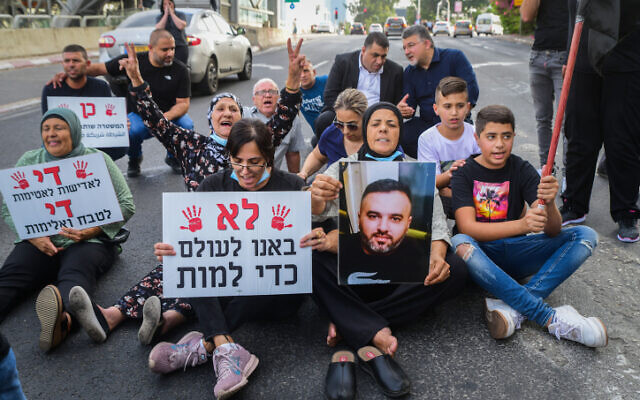
And one of the things is, that blaming the Arab society will not make them take any responsibility. So I’m not saying again that we, Arab society, can’t be blamed for anything. Okay? No, we also should take responsibility because we have some things that are related to us, and we are responsible for that.
But for all these organized crimes, the normal citizen can’t help it, we can’t solve it. And also our politicians, some people say, why do the politicians not stop it? What do you expect from them, to go collect the guns? Like it’s not already the rule? There is a police in this country, and the police should not act, as if it’s in kindergarten, that they are getting humiliated by Arab society if they are attacked. No, you are the police. You should continue and be consistent in your aim to solve this problem. You can’t, if you are attacked, then say, I’m not going there anymore. It’s not a kindergarten. It’s a huge problem and you should take responsibility, as a state, to solve this problem in Israeli society. Again, it’s not of Arab society.
So words have power, as you know. And I understand that in Hebrew media, for instance, there’s a lot of talk of “Arab violence” and this can happen, of course, in English media as well, that it’s not “violence in Arab communities,” it is “Arab violence.” Are you finding that yourself?
Yeah. And of course, people here it’s not only in the media. Politicians say the violence happens because it’s in our culture. And this is why I emphasize when we started talking, that despite the unfortunate number of killings, and people who are killed now, and victims of violence, the majority of us are not violent. So you can’t say culturally, otherwise I would be violent towards you now. So it’s not the situation.
We are two million. There are a number of us who are violent, but not because of our culture. There are many reasons why this violence is happening here. And if you want to see if it’s a culture of violence or something like that, we can see that two children who are raised in the same place, in the same home. One is violent and one is a very educated, working, normal person. So there is something that is making some people violent [and not others]. And we know that there is no one single reason for being violent. There are many reasons.
And if we want to solve the problem, we have to touch all of them. We can’t say it’s only the culture, it’s only the police, it’s only the Arabs, it’s only the socioeconomic status. And the example I gave earlier about this comprehensive intervention is that everyone takes responsibility for their duties and then the violence can be lowered and can be solved. But otherwise, if you keep blaming one another, it will not be resolved at all.
Mona, I thank you so much for your thoughts, really.
Thank you, thank you for discussing this very unfortunate situation.
What Matters Now podcasts are available for download on iTunes, TuneIn, Pocket Casts, Stitcher, PlayerFM or wherever you get your podcasts.
Check out last week’s What Matters Now episode:
There's no paywall on The Times of Israel, but the journalism we do is costly. As an independent news organization, we are in no way influenced by political or business interests. We rely on readers like you to support our fact-based coverage of Israel and the Jewish world. If you appreciate the integrity of this type of journalism, please join the ToI Community.

We’re really pleased that you’ve read X Times of Israel articles in the past month.
That’s why we started the Times of Israel eleven years ago - to provide discerning readers like you with must-read coverage of Israel and the Jewish world.
So now we have a request. Unlike other news outlets, we haven’t put up a paywall. But as the journalism we do is costly, we invite readers for whom The Times of Israel has become important to help support our work by joining The Times of Israel Community.
For as little as $6 a month you can help support our quality journalism while enjoying The Times of Israel AD-FREE, as well as accessing exclusive content available only to Times of Israel Community members.
Thank you,
David Horovitz, Founding Editor of The Times of Israel


